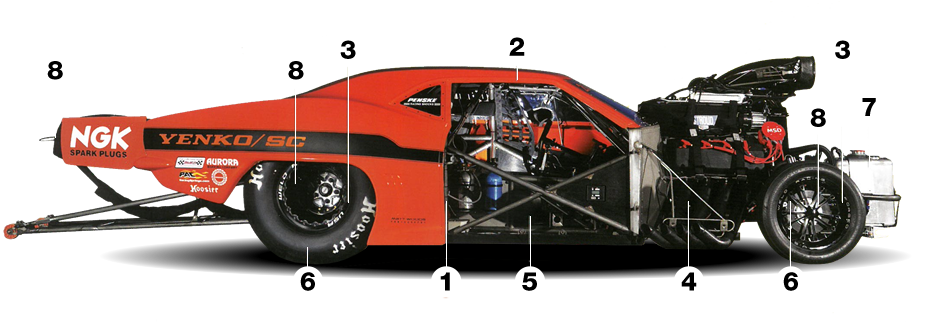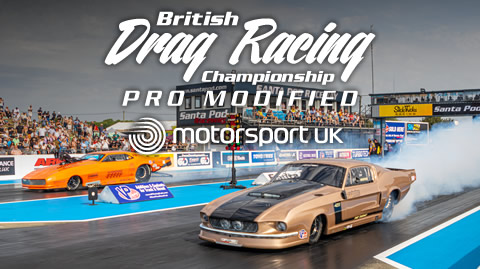What is Pro Mod?
Pro Modified Cars are 200mph doorslammers, running on petrol or methanol. They are the fastest class of drag cars with working doors; only rail Dragsters and Funny Cars are quicker.
Pro Mods are purpose-built race cars cloaked in replica street car bodies ranging in style from the 1930s to the present day.
Anatomy of a Pro Modified
Below is the anatomy of a typical Pro Mod, though cars do vary in detail.
Specifications
Pro Mod cars are allowed to run either a nitrous assisted engine running on unleaded race fuel or a supercharged or turbocharged engine running on methanol. The complete car including driver has to weigh a maximum of 2350lbs for cars with a nitrous engine or 2650lbs for a supercharged or turbocharged engine. Nitrous or blown motors cost approximately £60,000 from a recognised engine builder. Connecting rods last up to 20 runs on a blown car and up to 50 runs in a nitrous car. Valve springs are consumable items and individual pistons and rings need changing on a regular basis. A blown car would change spark plugs either every run if they wanted to ·read' the plugs or every 2 or 3 runs if not. A Pro Mod car will produce around 2600-3200 horsepower and the fastest will rundown in the 5 second zone.

1 - Chassis
Each chassis is custom fabricated from 4130 chrome moly tubing according to strict rules. The maximum permitted wheelbase is 115" (2.92m). Features of the chassis include twin chassis rails, strut style front suspension, carbon or aluminium interior panelling, aluminium motor mounting plates, coil over rear suspension and a 4 link mounted axle. The bare chassis weighs only 200-350lbs (90-159kg). Current cars are making much more use of lightweight materials such as carbon fibre and titanium.
2 - Body
Pro Mod body shells are highly modified replicas of original car bodies built in composite materials. The bodies may have been roof chopped, sectioned, stretched in the wheel base, scaled from the original or otherwise modified to give better aero dynamics and accommodate the huge rear tyres. The maximum front overhang is 45" (114cm.) A rear wing is added to give down-force at the top end of the track. A central driving position is not permitted. On this particular car the rear bodywork is supported by a carbon fibre spine and the whole of the body can be removed.
3 - Suspension
Cars are required to run with a damper and spring on each corner of the car. Double or triple adjustable coil over shock absorbers are commonly used as well as electronic control of the damping.
4 - Engines
The cubic capacity of nitrous engines is unrestricted and can range to over 900 cubic inches using either carburettors or EFI and multi stage nitrous systems to make power. Supercharged combinations are allowed a maximum of 527 cubic inches and must use a 14/71 roots style supercharger running no more than 20% faster than crank speed. Turbo charged engines can run a maximum of 540 cubic inches with a maximum of two 91mm turbos. In addition, the blown entries are restricted to a maximum valve size of 1.9" exhaust and 2.4' inlet and are restricted to 20% overdrive when using the 14-71 high helix blower. Nitrous motors are producing in the region of 3 horsepower per cubic inch and blown motors 5.31 horsepower per cubic inch so the difference in engine size, minimum car weight etc. are designed to redress this balance so that both combinations can be competitive.
5 - Drivetrain
Pro Mod cars can either use a multi disc clutch or a torque convertor drive unit (which uses a transbrake for launching. Some cars use a clutchless style gearbox using either a planetary style design such as a Lenco or B&J or in the case of some nitrous cars. a twin layshaft design such as a Liberty or G force. Some cars are now also using an automatic transmission based on a Turbo 400 or Powerglide transmission. Nitrous cars generally use a 4 or 5 speed transmission and blown cars have to use a 3 speed. Blown cars are permitted a maximum rear axle gear ratio of 4.56:1.
6 - Wheels & Tyres
Rear wheels are 16" in diameter and 16" wide and have to be 'Beadlock's i.e. have clamping rings to secure the tyre and stop it from rotating on the wheel or they have to run liners inside the tyre. Rear tyre pressures are from 5 psi and front tyres run up to 35 psi. The rear tyres are designed to 'crinkel' to assist the launch and will 'grow' by approx 4" in height during the burnout and at the top end of the track.
7 - Fuel
Nitrous motors use an unleaded high octane race fuel or methanol, the blown and turbo charged cars use methanol. The fuel system on a nitrous car can flow up to 8.5 gallons per minute and the blown car fuel system can flow over 15 gallons per minute. In a blown methanol car each run would use up to 25 litres including the burnout. In a nitrous car unleaded race fuel is used and each run would use approx 5 litres as well as 6lbs of nitrous oxide.
8 - Brakes
The cars are equipped with aftermarket disc brakes on all four wheels with newer cars using carbon fibre discs and pads. The brakes are used in conjunction with dual parachutes to slow the cars down from speeds of up to 250mph. Brakes are generally single pot on the front and 4 pot on the rear with the system designed to rear bias through the large rear wheels and tyres.
Data Logger
Almost all Pro Mod cars have a datalogger onboard which monitors and records in formation from sensors all over the car. The data is used to make the fine clutch adjustments which are essential to get the car to run fast. Other sensors monitor exhaust gas temperatures from each cylinder, cylinder head temperature, fuel flow, throttle position and rear suspension travel.







